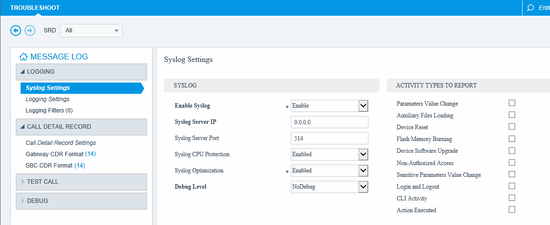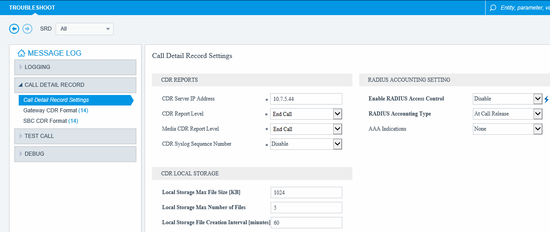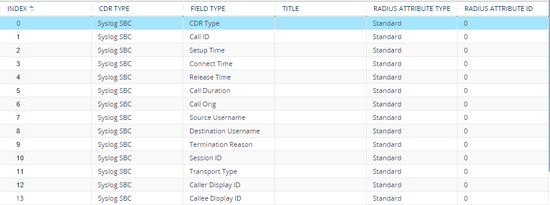AudioCodes Mediant 1000 - Call logging & accounting
This data is being extracted with help of the "Advanced PBX Data Logger" software only. It may not be applicable for other software titles.
Configuring CDR
Note: For CDR reporting, you must also enable the Syslog feature.
1. Open the Syslog Settings page (Troubleshoot menu > Troubleshoot tab > Logging folder > Syslog Settings).
2. From the Enable Syslog drop-down list, select Enable.
3. Specify the Syslog Server IP address 0.0.0.0.
5. Specify the Syslog Server Port number (default: 514).
6. Open the Call Detail Record Settings page.
7. Under the CDR Reports group:
7.1. Specify the IP address of your computer or server with Advanced PBX Data Logger in the CDR Server IP Address field.
7.2. Select End Call in CDR Report Level and Medial CDR Report Level drop-down lists.
7.3. Select Disable in CDR Syslog Sequence Number.
SBC CDR Format
8. Open the SBC CDR Format page.
9. Define fields as showed on fig. 3 (the column order is important).
Gateway CDR Format
10. Open the Gateway CDR Format page.
11. Define fields as showed on fig. 4 (the column order is important).
Configuring Advanced PBX Data Logger as a TCP server
Advanced PBX Data Logger should be configured to the TCP server mode and listen on 0.0.0.0:514 (see below). The IP address 0.0.0.0 allows receiving data from all network connections on your computer. The port number should match the value from the SMDR settings in your AudioCodes Mediant 1000.
1. Add a new configuration with the TCP data source (if you didn't it before).
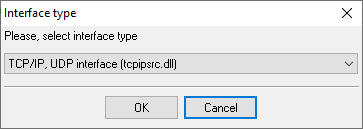
2. Configure the TCP settings as shown below.
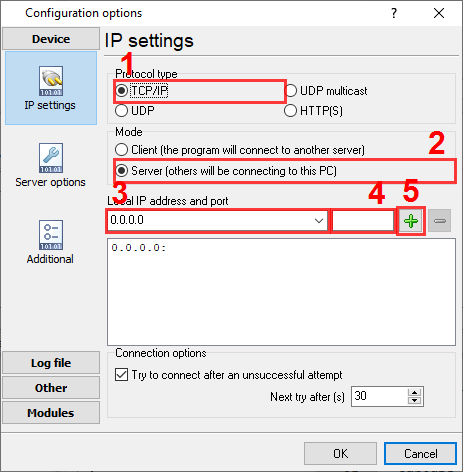
514
514
Selecting the correct parser for AudioCodes Mediant 1000
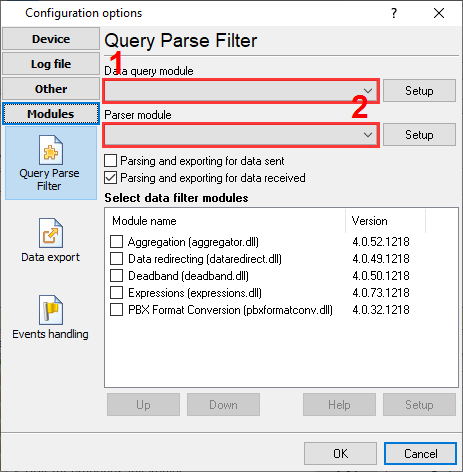
AudioCodes Mediant 1000
AudioCodes Mediant 1000
Data items
| Description | Data type | Column name |
|---|---|---|
| Call type | string | CALL_TYPE |
| Call time | datetime | CALL_TIME |
| Connect time | datetime | CONNECT_TIME |
| Release time | datetime | RELEASE_TIME |
| Ring | datetime | RING |
| Call Identifier | string | FLAG6 |
| Call Originator | string | FLAG5 |
| Direction | string | DIRECTION |
| Trunk | string | TRUNK |
| Ext | string | EXT |
| Dialed IP | string | DIALED_PHONE |
| Caller phone | string | CALLER_PHONE |
| Source URL | string | FLAG1 |
| Destination URL | string | FLAG2 |
| Call duration (sec) | integer | CALL_DURATION_S |
| Call duration | datetime | CALL_DURATION |
| Termination Reason | string | FLAG7 |
| Caller Display ID | string | FLAG3 |
| Callee Display ID | string | FLAG4 |
| Termination Reason | string | TERM_REASON |
| Termination Reason Categoty | string | TERM_REASON_CAT |
| IP Group Name | string | IP_GROUP |
| SRD ID and Name | string | SRD_ID |
| SIP interface ID | string | SIP_ID |
| Proxy Interface ID | string | PROXY_ID |
| IP Profile ID | string | IP_PROFILE |
| Medial Realm ID | string | MEDIA_REALM |
| Direct Media ID | string | DIRECT_MEDIA |
| SIP Termination Reason | string | SIP_TERM_REASON |
| SIP Termination Description | string | SIP_TERM_DESC |
Interested in reports for PBX usage?
We provide the PBX Reports utility, featuring a range of manual, scheduled, and email reports, a built-in web server, among other features. Implement your call accounting system for AudioCodes Mediant 1000. Check our PBX Reports utility.
Want PBX call logs in a database?
This standard feature allows the logger to capture and export SMDR or CDR data in real-time directly to your database. Check our article about call logging to a database.
AudioCodes Mediant 1000 related connection settings
AudioCodes Gateway (Extended)Asterisk Fonality (CSV)
AudioCodes SBC
AudioCodes VoIP Gateway
Quick jump to the connection settings for other PBXs or connection formats ↴
Note: Products and companies mentioned here are used only for definition and identification purposes and can be trademarks and/or registered trademarks of the respective companies.
Related topics: Advanced PBX Data Logger
hereCall logging Call accounting SMDR to SQL SMDR Listener Cables and signals
